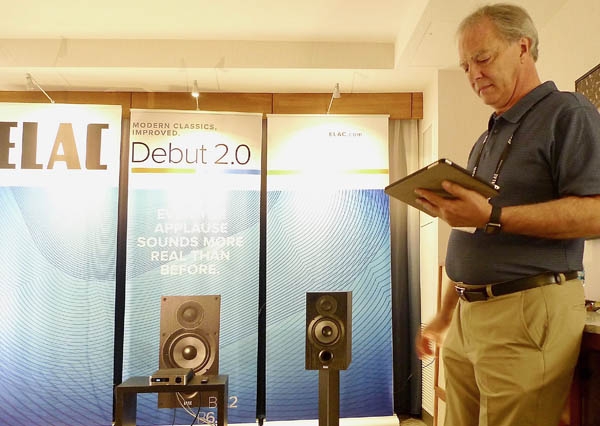| Columns Retired Columns & Blogs |
Day Two with Herb

Who doesn't like and admire Elac's chief loudspeaker designer (formally of KEF, TAD, and Pioneer) Andrew Jones? I surely do: but not only for his abilities to create high-value, low-cost, audiophile-quality speakers: I admire him for how he makes me feel when he stands in front of a packed audio-show room and tells stories plays songs…and smiles that wicked British smile he uses to suck us all in.
The Andrew Jones Experience was the best song-and-dance/dog-and-pony/beautiful-music moment at Axpona 2018. He was demonstrating Elac's $299.98/pair Debut 2.0 DB62-BK (who thinks of these names?) bookshelf speakers to spectacular effect. I have sat in the crowd many times watching Andrew and his iPad lure me into a series of wow moments, but this, I think, was his best.
The Debut 2.0 delivered those rich midrange textures and tonal saturations I demand. This budget system had Wile E. Coyote vs Road Runner speed and, most surprisingly, it could dance a delicate dance: something we always pay extra for.
During Tom Waits' "Way Down in the Hole," I kept asking myself: Could the DAC in Elac's $699.98 EA Series EA102EQ-G integrated amplifier be that good? The sound was clear and supple and never ones-and-zeros mechanical. Texture was major rich and deep. Beats were strong and rhythms were bendy. The DB62-BK felt loose but still properly damped. All this complex, layered sound was supplied by Elac's $1099.98 DS-S101-G Discovery Music Server. But wait! Stop the presses! The Debut 2.0s were connected to the Elac integrated via their new $69.98/pair prototype speaker wire. What's not to like or admire about Elac?

Obviously, Elac likes smart designers, so when they teamed up with distinguished amplifier designer Peter Madnick, I applauded. I am a forever fan of Peter's cost-effective creations for his old company, Audio Alchemy. His work for Elac is called the "Alchemy Series" or "Alchemy by Elac." His room featured Elac's $2499.98 Miracord 90 Turntable with a $1999.95 Soundsmith Zephyr moving-iron cartridge and showcased the DDP-2 preamplifier/DAC ($2499.98), DPA-2 stereo amplifier ($1499.98), and the PPA-2 phono preamplifier ($999.98).
Madnick was using two DPA-2 amps (configured in mono) to drive Elac's Adante loudspeakers ($2499.98/pair). He played Dire Straits, Chuck Mangione, and a MoFi reissue of Steve Ray Vaughan and Double Trouble's 1984 classic Couldn't Stand The Weather. Unfortunately, I struggled to like the sound. Audiophiles love this recording because it is pure and punchy with lots of white bluesman attitude—all traits they desire for their system and, I suspect, aspire to themselves. With the Elac Adantes, the sound was pure and punchy enough, but too hard for my taste. Worst of all it failed to convey Vaughan's restrained coiled-snake-pressure-needs-release attitude and freewheeling guitar rhythms. I have a feeling: Elac's Debut 2.0s would have handled this recording much better. Just sayin'…

The Kimber/Woo Audio Room was the coolest audio-show display I have so far encountered. First off, it was a long rectangular duplex with what seemed like a mile of high glass and a panoramic view. While I was absorbing the spectacle, long-time/no-see friend Ray Kimber tapped me on the shoulder. He showed me a slew of cables with different connectors and eagerly described his Axios line of handcrafted headphone cables. (You can see me talking to Ray—our backs facing the camera—in the photo above.) Folks, audio expositions rock. Where else could you go and sit leisurely, comparing cables on a wide variety of headphones attached to world-class Woo Audio amplifiers? I used the Kimber Axios for my Sony MDR-Z1R review and loved them, so I told Ray I wanted to try Axios on my Audeze and HiFiMan phones. I hope that happens.
When I turned around, there was Jack Woo (also in the photo above, in the white shirt), proprietor of Woo Audio and maker of many of the world's finest headphone amplifiers. I had a difficult time conversing and looking Jack in the eye because I kept spying over his shoulder at his $8999 3ES Electrostatic Headphone Amplifier, with one of its outputs connected to a pair of Stax SR-009s ($3799) and the other connected to the $1499 Stax' SR-L700 Lambda open back electrostatic earspeakers…

Put Wilson, YG, Golden Ear, and Raidho out of your mind; you could have taken the best sound at Axpona 2018 home in your suitcase! The 3ES's dual stacked chassis might net you some excess-weight charges when you check your baggage, but who cares? When you arrive home you will be enjoying the most lively, transparent, and deeply descriptive two-channel sound on the planet: Each Woo 3ES channel employs dual (parallel single-ended) directly heated 300Bs driven by the venerable 6SN7 dual-triode.
Using the SR-009, I listened to some Bill Evans recordings, and then the Beatles' "Eleanor Rigby," and my brain kept interrupting the musical flow with images of WOW emojis and "Maybe this is it?" exclamations. Instruments and voices were never too light or artificial sounding—nor were they too heavy, punchy, or overbalanced towards the bass (which had weight but not extension). If you bought your Stax SR-009 earspeakers for their perfectly fleshed-out midrange, you can trust the Woo amplifier to tease out more color and vivid detail than you ever dreamed possible. The treble region was as close to perfect as I have experienced. I only had a short listen, but this felt like a taste of a new super-drug. This combination is a must audition for ALL two-channel connoisseurs.

I always enjoy visiting Vinh Vu, president of Gingko Audio and Danacable. He plays music I like, always gets good sound, and helps me understand the sometimes-unusual lineup of products he demonstrates. This year was no exception.
The $9000 Made in America Gingko Audio ClaraVU 7 Mk.3 modular speaker system consists of a top-mounted monitor speaker with a 6.5" paper cone bass-midrange plus a 1" slightly horn-loaded silk dome tweeter, combined with a horn-loaded ribbon super-tweeter that Vinh Vu said crosses over at 20kHz. "But Vinh, my ears cross over at 10kHz!"
The bottom (bass) cabinets feature compound-loaded 6.5" cones, and stack neatly and handsomely below the monitor cabinets. Impedance is nominally 10 ohms with a specified minimum of 8 ohms. Sensitivity is 85db/1W/1m.
The $6500/pair Triode Corp of Japan TRX-P3M amplifiers employ parallel single-ended 300B tubes, which Vinh says put out 20Wpc, and I believe these handsome-looking monoblocks were the core reason every recording sounded so pure and unaffected. The longer I listened, the more I felt these amps were generating some form of distilled magic. Therefore, curiosity roused, I asked for a review sample.
The preamp was the Wells Audio Commander ($4000); the DAC was the Denafrips Terminator—a $4500 ladder DAC that I have heard a few times and also rouses my curiosity. The refined-sounding Gingko room system also included a $1700 Gen. III Salk Stream Player and, of course, Danacable's Sapphire and Diamond cabling.
Vu's system had one more very intriguing (to me) product: Under the speakers were Gingko Audio ARCHs—compact layered-wood vibrational-control devices shaped like automotive leaf springs. They come in a variety of sizes and thicknesses and look like they might actually work better than pointy spikes, pliant silicone, or hard roller-ball bearings. There was a lot to study and think about in Vinh Vu's room.
- Log in or register to post comments




































